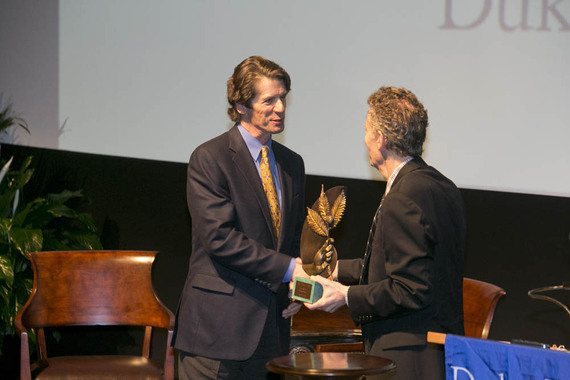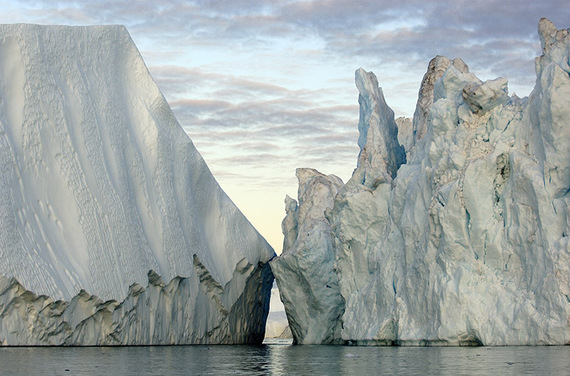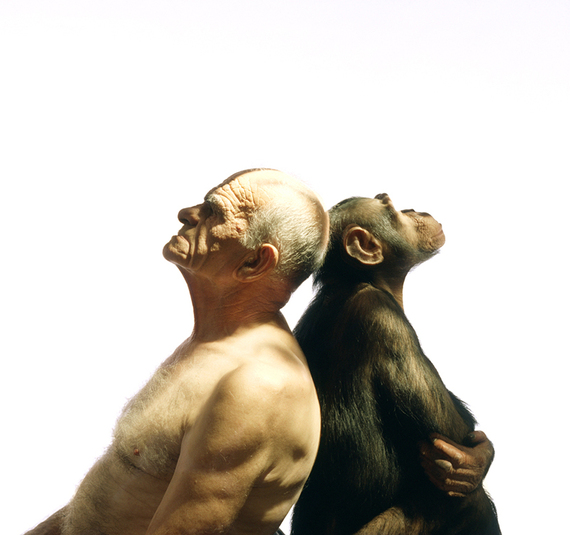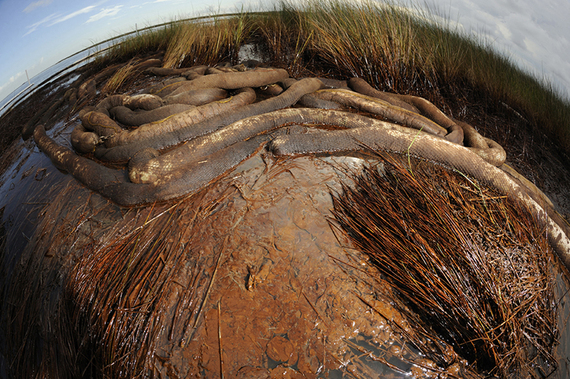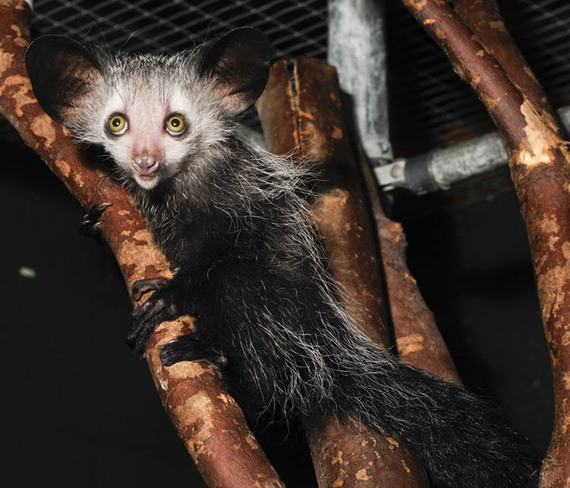The cameraman featured in the Oscar-nominated film Chasing Ice has captured a lot more than ice with his lens.
Artists -- they have extraordinary talent and power to reach deep down into people and challenge them to question their assumptions, to see the world in a new way, and perhaps even to change how they live. And with that opportunity, I would argue comes a responsibility. A responsibility to use those talents in a constructive way. Some artists accept, even embrace that responsibility choosing to make the environment a major theme of their work in the hopes of connecting people in an emotional, visceral way to our planet and its stewardship.
The Duke LEAF Award for Lifetime Environmental Achievement in the Fine Arts was established in 2009 to call attention to and honor that kind of artist, the kind of artist
“whose work has lifted the human spirit by conveying our profound spiritual and material connection to the Earth and thereby inspiring others to help forge a more sustainable future for all.”
This past weekend we bestowed the 2014 LEAF on James Balog.
Balog the Leaper
Balog is one of many talented and accomplished nature photographers that bring the images of flora and fauna, ocean and mountain to me and my fellow arm-chair naturalists.
But I think Balog is unique.
By melding his artistic sensibilities with his knowledge as an earth scientist and his love of the outdoors borne of youthful years spent mountain climbing and camping, Balog has created a body of work that is singular, informative and profoundly moving.
During his visit, Balog related a story with a surprising turn of events, a turn that led him to find his life's work seemingly by accident and serendipity.
As a young man, the now-consummate photographer did not consider photography as a possible future profession. He saw himself as a scientist and more specifically as an earth scientist. However, after publishing his first scientific paper and beginning to contemplate life after earning a master of science degree in geography from the University of Colorado, Boulder, Balog decided that the life of a scientist wasn't for him after all. What then, he recalls asking himself? He knew he liked photography and being outdoors. And so, just like that, he became a nature photographer.
It was a leap to be sure and not an easy one. Balog relates that he had no formal education in photography and had to teach himself by trial and error how to master his craft.
But, at least in this case, talent won out and it wasn't long before his work began appearing in National Geographic, The New Yorker and Life magazine -- and being recognized for its excellence (e.g., First Prize, World Press Photo Contest (1986), International League of Conservation Photographers Inaugural Award (2009), PhotoMedia's Photography Person of the Year (2011)).
And it would appear that all that early training as a scientist was not for naught. In addition to the accolades from the worlds of journalism and photography, his work has also been recognized by the scientific community: for example, an Honorary Doctor of Science Degree from the University of Alberta and the American Geophysical Union Presidential Citation for Science and Society.
Balog the Ice Man
Balog is probably best known as the central figure in Chasing Ice, the award-winning documentary chronicling his work leading the Extreme Ice Survey -- a project that has provided the world a unique and dramatic visual record of the alarmingly rapid retreat of glacial ice due to global warming.
The film is stunning and moving in terms of the remarkable beauty of the images captured, the undeniable evidence it provides that our world's ice is disappearing as we dither about climate change, and the story it tells of Balog's dogged determination to bring what had probably seemed to many a quixotic dream to fruition.
Balog the Artist
Quite often when environmental photography comes to mind, we think of idyllic pictures of pristine environments -- the kind of images that the Hudson River School made famous using the medium of oil painting and that Ansel Adams captured on film. Beautiful and inspiring as they may be, this is not what Balog has aspired to capture in his work.
Balog told me he wants his work to be about the collision between humanity and the rest of nature, a sentiment he accented by pumping his right fist into the palm of his other hand with a pop. Rather than pristine environments, Balog looks to produce images where the mark of humanity is at least implied if not obvious.
Of course the opposite of an idyllic scene a la Ansel Adams is one that depicts an environmental disaster -- birds unable to fly because of an oil spill, smog-choked cityscapes, dead fish along a polluted stream. Pictures that seek to shock in order to get people’s attention. But while such photographs do portray the collision between nature and humanity, they rarely characterize a Balog photograph.
I find that Balog's work carries a more nuanced message -- one that draws people into the picture, making them a part of the scene, rather then seeking to shock and recoil.
For example, consider the photo above from his Tectonics-Natural and Human collection. It's a photograph of oiled wetland grasses following the Deepwater Horizon oil spill. The devastation from the oil is apparent, but I don't find it shocking -- for me it is oddly perplexing and intriguing. I have seen many, many photographs of the damage to wetlands from oil spills, but none like this one.
I find myself drawn in, trying to understand what it is I am seeing, in a sense becoming a part of the scene. Are those wetlands or is it the pate of a balding head covered in oil and muck? Is Balog trying to show us that we all get just a little bit oiled when our wetlands are decimated by an oil spill?
Of course, if you're trying to engage people with a picture, photographs capturing animals as the subject can be quite effective.
And animals have certainly been the subject of many a Balog photograph. I think it's clear from these kinds of photos that Balog has a special fascination with our furry friends -- a fascination that appears to be mutual.
As illustrated in his Endangered Wildlife collection, there is something extraordinarily captivating and personal, almost intimate about his animal photographs. Each photograph in this series provides us with a deep face-to-face encounter with an animal whose existence on this planet is very much in question.
Balog takes his art and the environmental message it carries quite seriously, but he is not above using humor to carry that message home as he does in "The Old Man and the Ape." (See image above.)
Balog Wanted the Lemur
Balog and his traveling companions -- wife Suzanne and younger daughter Emily -- made full use of their visit to Durham and Duke, checking out the sites in addition to attending the LEAF award festivities and meeting with students. While I thought Balog enjoyed the ceremony honoring him, it was pretty clear that the highlight of his trip was his tour of the Duke Lemur Center.
He apparently especially bonded with one lemur -- I think it was an aye-aye like the one above. During his acceptance speech he thanked us for the award but said he wasn't leaving until he was also given a lemur. I'm pretty sure it was tongue and cheek since the very next day they headed off to the airport, Suzanne and Emily to Boulder and James headed to Pennsylvania to continue to spread the word about climate change, and no one has been reported missing at the Lemur Center … as far as I know.
Keep up with TheGreenGrok | Find us on Facebook
